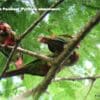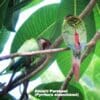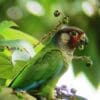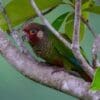Azuero Conure
Also known as:
Azuero Parakeet
Also known as:
Azuero Parakeet
DID YOU KNOW?
The Azuero Conure is closely related to the Painted Conure (Pyrrhura picta).

Pyrrhura

eisenmanni
Size:
22 cm (8.6 in)
Weight:
Probably 54-70 g (1.9-2.5 oz)
Subspecies including nominate:
one
Colour Adult:
Both adults mainly green; black/brown forehead and crown to nape; frontal band to lores and around eyes thin and red; buff/white ear coverts; faint, blue nuchal collar; dark brown upper breast scalloped with white; dark green/blue lower breast scalloped with buff/white and yellow; green bend of wing. Beak black. Eye ring bare and grey/brown. Eye brown yellow.
Colour Juvenile:
Undescribed.
Call:
Calls made in flight are short; some single loud notes from birds contact calling flock; while perched harsh, gutteral notes; soft notes while preening.
More Information:
Content Sources:
BirdLife International
A Guide to Parrots of the World, Juniper and Parr, 1998
Cornell Lab of Ornithology/Birds of the World
Parrots of the World, Forshaw, 2006. 2010 edition
Vanished and Vanishing Parrots, Forshaw, 2017.
Parrots in Aviculture, Low, 1992.
Lexicon of Parrots, Thomas Arndt.
Captive Status:
Almost unknown in captivity.
Longevity:
Probably 12-15 yrs, as for Painted Conure.
Housing:
As for Painted Conure: aviary or suspended enclosure, minimum length 2 m (6.5 ft).
Diet:
As for Painted Conure: fruits such as: apple, pear, banana, orange, pomegranate, kiwi, papaya, forming about 30 percent of diet; vegetables such as: carrot, celery, green beans and peas in the pod; fresh corn; green leaves such as: Swiss chard, kale, dandelion, sowthistle, lettuce, chickweed; spray millet; small seed mix such as: millet, canary, and smaller amounts of oats, buckwheat, safflower and a little hemp; soaked or sprouted sunflower seed; cooked beans and pulses, boiled maize and complete kibble.
Enrichment:
As for Painted Conure: enjoys chewing so provide bird-safe, unsprayed flowering, fir, pine, willow and elder branches; wooden or vegetable tanned leather toys; foraging/puzzle toys; ladders, swings, multiple perches and ropes. Also provide overhead misters or shallow water bowls for bathing.
Nest Box Size:
As for Painted Conure: vertical box 8″ x 8″ x 28″ (20.3 cm x 20.3 cm x 71.1 cm)
Clutch Size:
4-8
Fledging Age:
40-51 days
Hatch Weight:
—
Peak Weight:
—
Weaning Weight:
—
World Population:
750-6,000 mature individuals.
IUCN Red List Status:
Vulnerable
CITES Listing:
Appendix II
Threat Summary:
The wild population is within a global range estimated at just 700 km² and there is concern that the species is declining due to ongoing habitat destruction, especially in N and NE of range. Cerro Hoyo National Park, where it does occur, appears largely intact. It is unclear if there is any risk to the species from trapping.
Range:
SW Azuero Peninsula, C Panama.
Habitat:
Found up to 1660 m (5445 ft) in humid, hilly forest areas, forest margins and sometimes nearby partly cleared areas.
Wild Diet:
Feeds on fruits, flowers, seeds, algae and invertebrates.
Ecology and Behaviour:
Resident, with possibly some local movements due to food availability. Usually seen in pairs or small groups, sometimes in flocks of up to 20 birds. Stays up in forest canopy, where inconspicuous amongst the foliage. Noisy and visible in flight.
Clutch and Egg Size:
Probably 4-8 eggs, 25.5 x 19.0 mm (1.0 x 0.7 in)
Breeding Season:
January-April. Nest is in tree cavity.
Related Links:
—
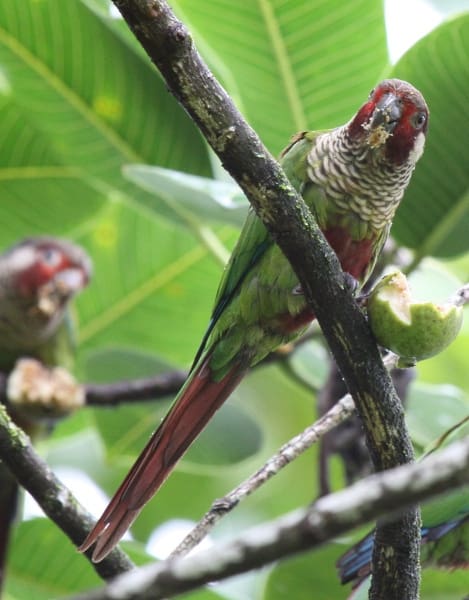
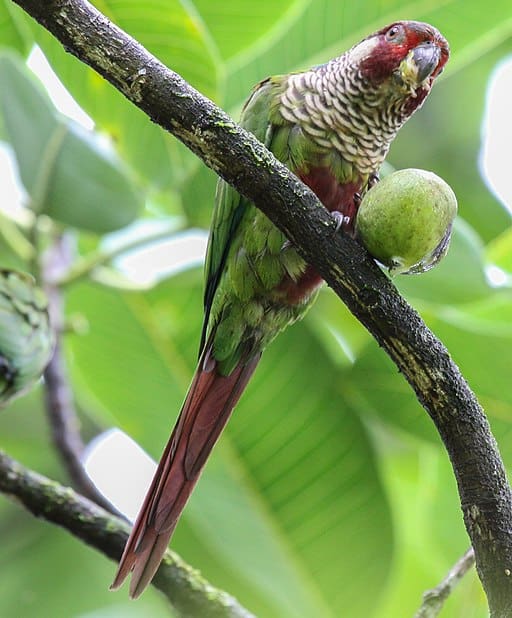
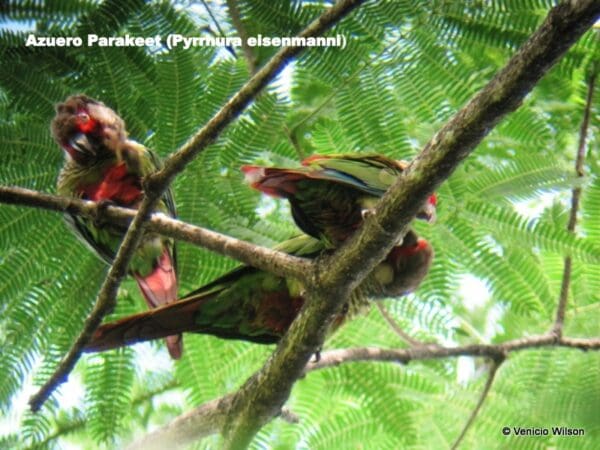
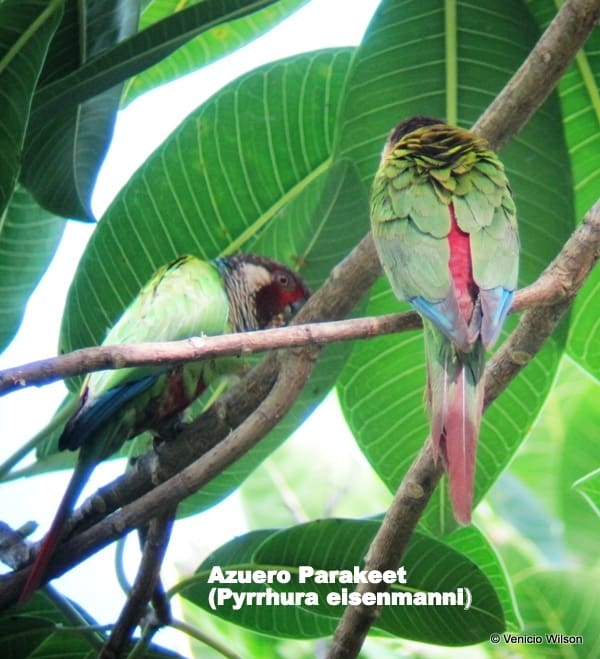
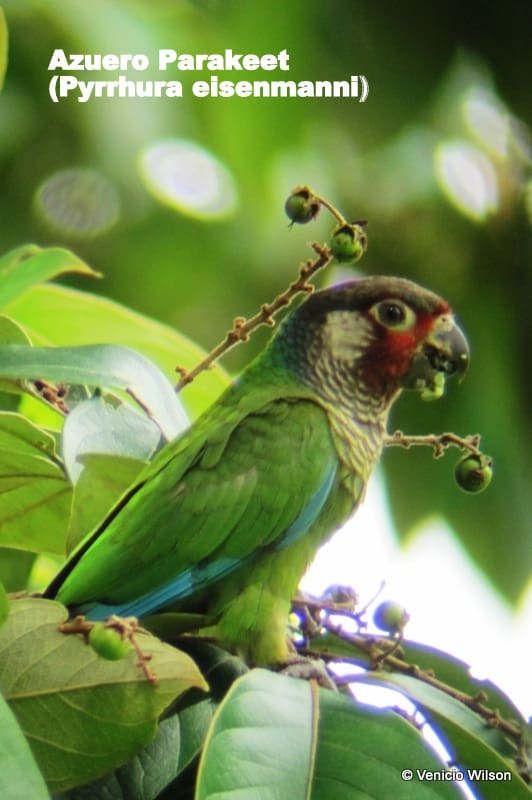
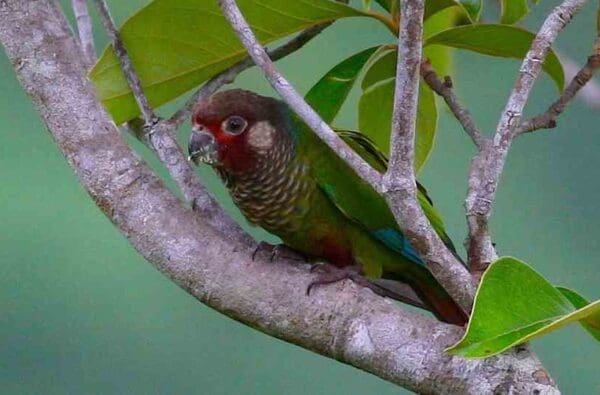
![© loes&kees [CC BY-SA 2.0] via Flickr Wild Azuero Conures feed on fruit](https://parrots.org/wp-content/uploads/2023/01/wpt_Azuero-Conure_1352-4-100x100.jpg)
![© Kees Groenendijk [CC BY-SA 4.0] via Wikimedia Commons A wild Azuero Conure feeds on fruit](https://parrots.org/wp-content/uploads/2023/01/wpt_Azuero-Conure_1352-5-100x100.jpg)
